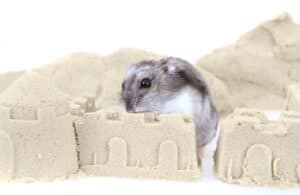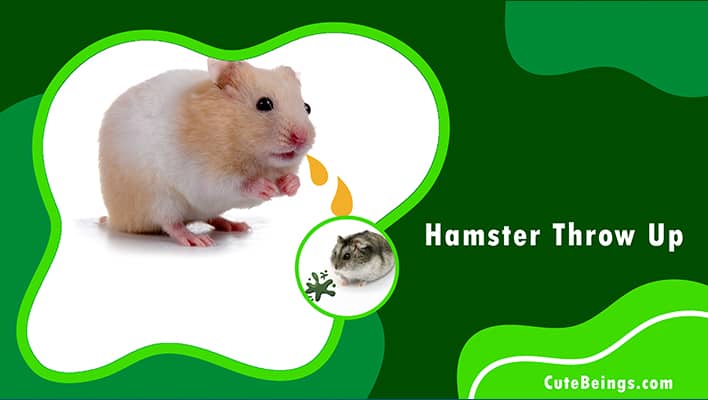We all have various pets and everybody’s choice is different. But most importantly we need to care about hygiene of our pet. As pet owners we need to keep our pet happy and clean so we need to find our own way to do it. Hamsters usually care a lot about their hygiene and they love to groom themselves habitually. These animals maintain a higher level of sanitation without seeking any support from their owners so they can be considered one of the cleanest in rodents. Even hamsters can’t clean themselves sufficiently, often bathing is not recommended as they can catch a cold so easily and that could be fatal to them. In this phenomenon Hamster Sand Bath can be introduced as a safer method of sanitizing your hamster without risking its life.
Table of Contents
Sand Bath And Hamster

Sand bath is a human made commercial product which is especially designed for hamsters and other small pets. Sand bath comes in various commercial names such as hamster bath sand, chinchilla sand bath and general purpose sand bath. If you are a hamster owner you can purchase this product in a pet store, online in main retail stores. In wild most animals use rough sand to sanitize themselves and this commercial product is made to imitate the same effect in safer and more disinfected confined setting.
Do Hamsters Need A Sand Bath?
Though you keep your hamster in a clean environment its fur could get oily or dirty in no time. As often water baths are not recommended for hamsters you need to go for an alternative method to clean your small pet.
Sand is a good substitute to water and usually sand is rough. For animals that can’t have frequent liquid baths sand makes the best alternative and sand bath could offer a fine level of hygiene. When hamsters roll in the sand bath it works to remove the excess dirt in the hamster’s coat. If there is any oils on hamster’s fur sand could absorb the excess oil from the fur and skin.
Choosing Right Sand – How to Choose the Right Sand For Hamsters?
Hamsters would dig into and tumble about in sand or gritty soil to scrub their bodies and fur in the wild. Rodent owners may purchase professional sand cleaning products internet or at their nearest veterinary supplies shops. These goods get created to mimic what they’d do to maintain themselves clean outside of the relatively antiseptic environment of their holder’s residence. If you decide on the correct sand for the purpose, the sand will extract sebum and humidity from their body. Consider The Following When You Purchasing A Sand Bath.
- The rough sand grains are gritty enough to scrape debris and other types of filth off the bunny’s skin without the necessity for liquid, which could render them susceptible to illness.
-
Do not purchase any product which is not particularly labeled for animal use.
-
See what you are buying. Do not purchase any dust bath products such as chinchilla dust. The particles in dust bath are not rough enough and could cause respiratory problems to your pet.
The sand you require is commonly branded rodent sand digitally at pet centers. This grit is dust-free and not so granular that it would endanger your pet’s pulmonary function. Bathing sand guarantees perfect skin and coating maintenance in tiny pets like rodents and chinchillas due to its all-natural recipe, free of allergens.
-
Do not buy harry hamster sand as its formula has been changed and now manufactured from clay.
-
Sand bath must not contain preservatives such as calcium. Some manufactures add nutrients which are not essential at all and your small pet doesn’t need this.
-
Choose a sand bath which is not scented. Most sand baths contain fragrances and these fragrances are not added for hamsters but for their owners.
How Often Do Hamsters Need To Have A Sand Bath?
You can decide how often you want to offer your hamster a sand bath. Some pet owners keep the sand bath in hamster’s cage so their pets can have a sand bath daily. Others may offer as sand bathing is needed.
Can You Keep Sand Bath In Hamster’s Cage?
Yes you can leave sand bath in hamster cage but you need check its condition time to time. If you keep it for a longer period eventually it will become dirty as it will absorb the dirt and oils from hamster’s furry coat. The other issue is your hamster may begin to use it as a litter box if it is always there. If that happens your hamster won’t be able to use it as a sand bath any more.
When You Should Replace The Sand Bath?
When the sand senses humid and the grains turn into solids, it’s time to change the sand bath. Otherwise it won’t offer the full potential to fulfill your expectancy.
Also you need to look out for any droppings in hamster bath and if there are some you need to remove those. If your hamster doesn’t leave droppings on sand bath you only have to replace it every few months.
You might be replacing the sand bath regularly and even without you knowing you are reducing the possibility of getting a bacterial infection of your hamster as moisture in sand bath offers a favorable condition for bacteria to grow up.
How to Choose Dish for the Hamster Sand Bath?
You provide your rodent with a sand bathing by adding an inch or more of a sand bathing item into a substantial bowl or holder that is huge enough for your hamster to move in serenely. Rodents are essentially not selective about the state of the bowl insofar as it is simple for them to move all through with sufficient space for development. A bowl like a wok, with an adjusted base, guarantees the sand doesn’t pack into corners.
Ensure the bowl is weighty enough that your rodent won’t flip it over while rolling or moving in and out. Try not to utilize bowls made of materials your hamster will be effectively ready to bite up, like plastic and wood. Place the compartment in the residing’s residing nook. Your rodent will find the sand shower in a perfect world and start moving in it. The readiness of the sand shower is simple. It requires several minutes before you’re prepared to put it into your rodent’s walled-in area. Follow these concise, bit-by-bit guidelines to effectively and immediately set up the dish so that shower time might start.
- Clean the washing dish thoroughly, ensuring that it is dry before use.
- Utilizing a tbsp, fill the dish with around 10 tbsp of your picked chinchilla or reptile sand.
- Place the sand bathing in the enclosure, ideally in a corner, to limit how much sand gets kicked around and beyond the bathing
When the rodent gets finished with their shower, the sand may be filthy. It must get taken out from the enclosure instantly to kill the gamble of collecting scents.
How Often Should You Sanitize Sand Bath Container Or The Bowl?
In some situations you can wait up to two weeks to clean up the sand bath container and the cage and this would be for one hamster. If you have more than one you won’t be able to wait two weeks to clean and cleaning once a week is recommended and due to the condition it might be twice a week.

How To Offer A Sand Bath To Your Hamster?
First check your hamster’s condition to identify whether it actually needs a sand bath. If the hamster is in good health condition and it really needs a dry shower then you can offer a shower.
If you are giving the sand bath for the first time you need to complete it without stressing out your hamster. Follow these steps to offer a successful bath to your pet.
-
Choosing the correct container or the bowl is very important and do not choose plastic or wood containers that could chew up by your hamster. Size is also important so choose a bowl which is big enough for your hamster to roll and move around. Also the bowl should be heavy enough so your pet won’t be able to flip it over as it gets in and out or while rolling around.
If you are unable to find a bowl at home you can purchase one from a pet store or online. Some of these containers comes with different sorts of sands.
-
Once you select the container clean it thoroughly and wipe properly to make sure it’s dry before using.
-
Then dispense the bathing sand you selected for an inch or two of height to the bowl or the container. The bath sand you chose should be pet safe sand and dust free sand such as chinchilla bathing sand, tiny friends farm and children’s play sand. The sand you offer should be clean and that is very important to hamster’s health.
-
Now everything is set and you can put your hamster into the sand container. Your hamster will find its way through sand. Though most hamsters like sand baths, some may not like it. Your hamster may not like it first but if you keep it inside the cage for some time your hamster will get use to it as your pet will have a mood to have a dry shower.
Wash the container and dry it as you get ready for your hamster’s next sand bath and most importantly contact your veterinarian immediately if you notice any difference in hamster’s behavior after the sand bath.
Bathing Schedule For Hamsters
Since you are utilizing pet-safe sand and residue-free sand, there’s no expression that you could not allow your rodent to take bathing consistently, assuming they need to. Numerous proprietors like to leave their pet’s sand washing dish in their enclosure with the goal that they might clean themselves and roll around for their recreation.
What’s significant here is ensuring that the sand stays clean. Messy sand won’t perfect a rodent’s body. Therefore, there are a lot of hamster proprietors who like to keep their hamster’s shower beyond their enclosure. Thus, honestly, it is all dependent upon you and your hamster. On the off chance that your rodent partakes in their sand showers, you can allow them to enjoy at whatever point they might want to with no mischief – as long as you keep their bathing sand tidy!
Benefits of Sand Bath For Hamsters
The advantages of sand bathing for rodents are huge concerning tidiness and tomfoolery. For rodents who appreciate slumping and moving around in the pet-safe sand, there could be no more exemplary method for getting new and scent-free! Be that as it may, on the off chance that your hamster doesn’t appear to appreciate it as others do, you don’t need to stress. Dust bathing is not crucial to hamsters’ wellbeing and bliss since their proprietors keep their walled in areas clean consistently and eliminate all filthy sheet material from the enclosure every day
You can’t force your rodent to wash excessively or minor, so they’re allowed to do it according to their preferences. Ensure that the sand, similar to the remainder of their current circumstance, is spotless consistently. Whenever you do this, your hamster will consider this piece of the prepping system to be an incredible sumptuous encounter.
Do Hamsters Show Any Interest In Sand Bathing?
Usually hamsters do not like liquid baths or simply water baths. When they start to show signs of dirtiness they would enjoy a sand bath to clean themselves.
It’s not just a bath this can be fun activity to your hamster. Hamster could roll around or play with sand it makes sand bathing a fun activity.
Why Hamster Won’t Use Sand Bath? – Everything You Need to Know
If you notice your pet is having fun while sand bathing you can spice it up by providing some exercise. In that way your hamster will be entertained easily. But not all hamsters would enjoy a sand bath so observe your hamster while sand bathing and sometimes you may notice that your pet is not a fan of sand bath. Nonetheless, some rodent caretakers have encountered at minimum one of the following issues with their furry companion:
- Reluctance to participate in the sand bathing
- Making use of the sand bathing as a toilet receptacle
Many rodents would adapt to their sand bathing without much prodding, but several hamster won’t use sand bath — and that’s fine! Your rodent is unlikely to become ill simply because they do not like to tumble about in the sand. If they don’t appear interested in utilizing it, immediately eliminate the sand bathing from their cage. It will keep them from urinating in what get intended to be their bathing.
You can give your rodent sand for bathing, but you can’t force him to utilize it. Many rodents like sand bathing; however, many do not understand how to behave or do not appreciate sand bathing. Allow your rodent enough time to find out how to behave with the sand bath if they do not use it right away. If you set the sand bathing in your rodent’s enclosure, inspect it frequently; some rodents may confuse the sand bathing for a sand potty.
Breed Difference
Hamsters of all typical home breeds, especially Syrian rodents, have been spotted enjoying sand bathing. The contrary is also accurate: rodents have thrown their nostrils at the sand bathing. It has little to deal with the hamster’s species but everything to go with their attitude and unique interests.
Anecdotally, pygmy rodents appear to enjoy sand bathing more than Syrian rodents. However, that doesn’t indicate your Syrian rodent won’t want a good rolling in the sand. It certainly doesn’t suggest that your pygmy rodent will be uninterested in their sand bathing. It’s good experimenting with every rodent to find out which one they favor. If your rodent is a Syrian, you’ll require a giant bathing bowl. If your rodent dislikes sand bathing, don’t keep the sand bowl in their enclosure, except you’re OK with them utilizing it as a sophisticated toilet box.
Sand Bath Or Dust Bath?
Both these products are very similar and these two are mistaken regularly by most pet owners. When you buy pay extra attention only to purchase sand bath.
Dust bath
Dust bathing is the same as sand bathing, and the two are frequently mixed up or traded. It is vital to focus on what you’re purchasing: Dust bathing items have better grain particles that can lead to respiratory issues for your rodent. Utilize just sand bathing. Utilize no stuff that gets named as a residue shower on your rodent. Utilize no item that isn’t named explicitly for use on pets. A few creatures benefit significantly from dust bathing, yet hamsters are not one of them. Shower bathing gets comprised of altogether more modest particles that can be handily breathed in by your pet and lead to respiratory issues.
Alternative Sand
Since specific excellent kinds of chinchilla or rodent bathing sand can be hard to track down or manage, caregivers have become innovative in finding different sand that admirably keeps their rodents blissful and clean. Reptile sand is another option; however, you should be cautious in settling on your decision, like with different kinds of sand. Particular reptile sand, mainly those containing calcium, can be hazardous to hamsters.
Reptisand is well-known sand utilized by numerous rodents caregivers. It is liberated from dust and possibly destructive calcium, making it an outstanding choice for concerned guardians of rodents. This sand is prepared to utilize right out of the sack and will generally cost apiece, not as much as chinchilla bathing sand. Likewise, kids’ recess sand is a well-known option compared to the business chinchilla and rodent sand bathing items. In any case, not at all like chinchilla sand and hamster sand. It should get disinfected preceding acquainting it with your hamster’s current circumstance.
Bottom line
Hamsters are generally hygienic creatures that often maintain themselves. Many rodents retain an excellent degree of hygiene on their own, with no help from their caretakers. Suppose your rodent is reluctant to groom himself enough. In that case, it gets generally suggested that you do not wash him in water since rodents can develop a virus fast and perish in the process. Sand baths are an alternate technique for cleaning your hamsters that is not harmful to their wellbeing. However, there is a chance that your hamster won’t use sand bath. This rodent sand bathing guideline discusses when to offer your rodent a sand bathing and how to get them acclimated to it.
A sand bathing is not the same as a typical bathing, such as one we could provide our pets. Pet-safe sand gets placed into a shallow container large sufficient for your rodent to enter and exit. And big sufficient to crawl around in there. Instead of washing filth from your hamster’s fur with soapy water, your rodent will tumble about and enjoy in the sand. It cleans their fur of oil and dirt. Animals in the outdoors frequently wipe themselves with dust and mud. Sand is inherently gritty and a helpful substitute for water for mammals who will be susceptible if they have bathed in water. The erosion caused by your hamster rolling in the sand bath removes superfluous contaminants from the fur. The sand absorbs excessive lipids and humidity from the body and skin.
Many hamsters will do great without ever taking a sand bathing. However, only if their enclosure is maintained immaculately tidy do they not have any medical issues that prohibit them from appropriately nurturing themselves.

Hello, my name is James and I’ve been caring for tiny pets for over 14 years with a passion. I enjoy passing on my expertise to other individuals in order for them to have the same amount of enjoyment as I do.




